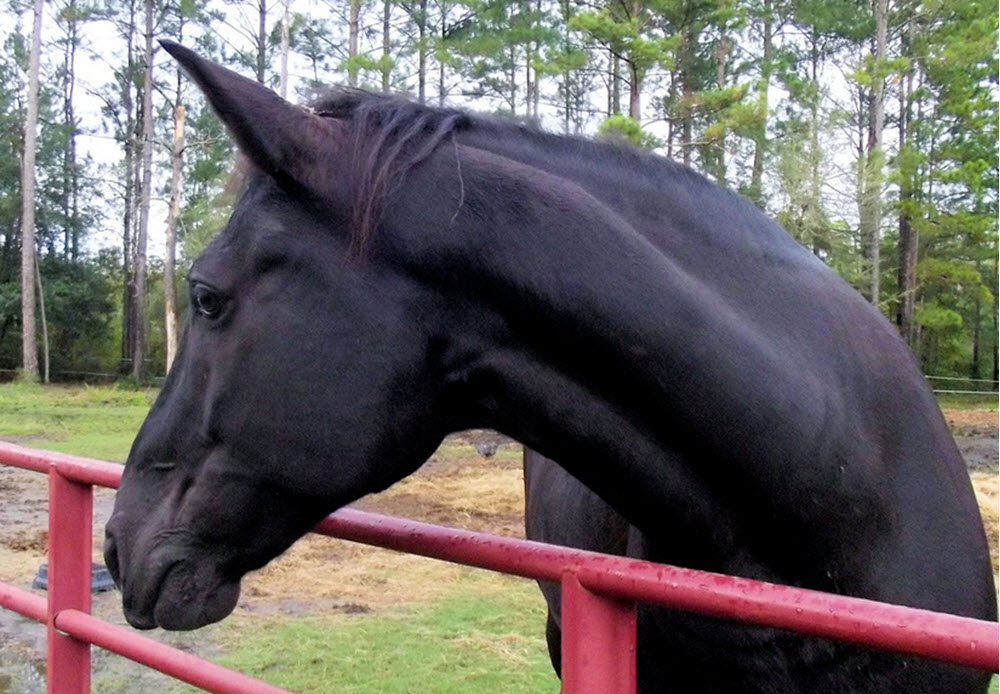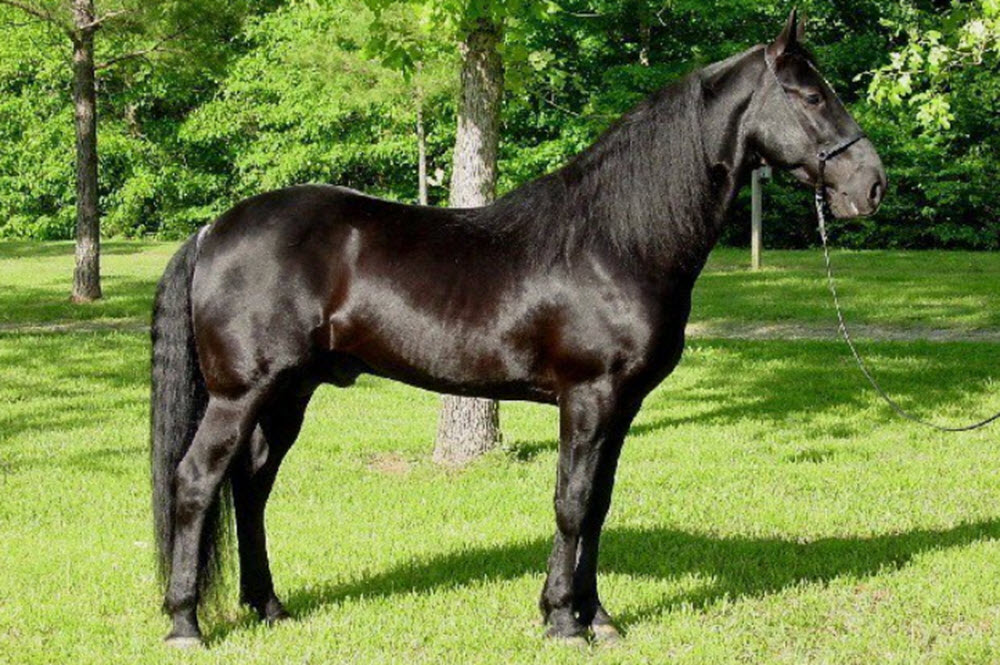On this page:
The Tennessee Walking horse (TWH), also known as the Tennessee Walker, is a gaited horse breed developed for farms and plantations in southern United States. It is known for its unique running-walk, which has become popular in horse shows and similar events.

It is chiefly kept in southern and southeastern United States, but found in other parts of the country as well, albeit in lower numbers. It is the third-most common breed in Kentucky, behind the Thoroughbred and the American Quarter Horse.
The Tennessee Walking Horse National Celebration, the largest horse show for the Tennessee Walking Horse breed, has been held annually in or near Shelbyville, Tennessee since its inception in 1939.
Official state horse
In the year 2000, the Tennessee Walking Horse was named the official state horse of Tennessee.
The Tennessee Walking Horse Breeder’s and Exhibitor’s Association
The breed standard is maintained by the Tennessee Walking Horse Breeder’s and Exhibitor’s Association.
Gaits
Running-walk
The Tennessee Walking Horse is famous for its running-walk; a four-beat gait where the horse moves at a pace of 10-20 miles per hour and nods its head in rhythm with its gait.
During this running-walk, the horse’s rear feet are overstepping the prints of its front feet by 6 to 18 inches. A long overstepping is much sought after in the show ring.
Flat walk
When the horse performs its flat walk, it moves at a pace of 4 to 8 miles per our, which is significantly slower than the running walk.
The footfall pattern is the same as for the running-walk, only slower.
Canter
The third main gait of this breed is the canter.
Other gaits
Some individuals perform other variations of lateral ambling gaits, such as the stepping pace, the fox trot, the rack, and the single-foot. These ambling gaits are penalized in the show ring.
There are also some individuals that can trot, although this is quite unusual in the breed.
Uses
Horse shows
This breed frequently appears at horse show events, especially at performances with saddle seat-style English riding equipment.
Riding
The breed’s naturally smooth riding gait and calm disposition has made it popular for pleasure riding (both English and Western, including trail riding and endurance riding.
Characteristics

Temperament
Calm disposition
Height
14.3 – 17 hands
Weight
900 – 1200 pounds
Color
This breed come in all solid colors, and several pinto patterns, including overo, tobiano and sabino.
Body
This is a tall horse, with a short back, a long neck, and a long, straight head. Most individuals display sloping shoulders and sloping hips. The ideal body is solidly built, yet refined and elegant.
The ears are small.
Relation to the the American Walking Pony
The American Walking Pony (AWP) is closely related to the Tennessee Walking Horse (TWH), because the TWH was bred with Welsh ponies to create the AWP.
History of the Tennessee Walking Horse
Origin
The ancestry of the early Tennessee Walker is chiefly comprised of Narragansett Pacers and Canadian Pacers from eastern United States, and gaited Spanish Mustangs living in Texas. These three breeds were mated with each other in southern United States in the late 1700s for work on farms and plantations. They were excellent “multi-purpose” horses that could be used for comfortable yet fast riding (they have a smooth gait) as well as pulling the plow or a buggy.
The early Tennessee Walker horses grazed on the limestone pastures characteristic of Middle Tennessee, where sure-footedness was an important trait because of the rocky terrain.
Later additions
Today’s Tennessee Walkers doesn’t hail only from Narragansett Pacers, Canadian Pacers, and gaited Spanish Mustangs, because quite a few Standardbreds, Thoroughbreds, American Saddlebreds, and Morgan horses have contributed to the bloodline as well.
The famous Black Allan
Black Allan (Allan F-1) is considered the foundation sire of the modern Tennessee Walking horse. He was born in 1886. His father was Allendorf, a stallion belonging to the Hambletonian family of Standardbreds. His mother was Maggie Marshall, a Morgan mare.
Black Allan insisted on pacing, and was therefore considered a failure as a trotting horse. In addition to the pace, he also did the lateral ambling gait that we today know as the running walk.
Black Allan was used as a stud, and one of his offspring was Roan Allen, born in 1904. This horse turned out to be capable of performing several ambling gaits, and became a successful show horse who also sired several famous Tennessee Walking horses.
The Tennessee Walking Horse Breeders’ Association
The Tennessee Walking Horse Breeders’ Association was created in 1935. In 1974, the name was changed to The Tennessee Walking Horse Breeders’ and Exhibitor’s Association (TWHBEA).
The stud book for the TWH has been closed in 1947, which means that since then, only horses hailing from two registered parents have been eligible for registration.
The Tennessee Walking Horse has been recognized as a breed by the U.S. Department of Agriculture since 1950.
Controversy
In the 21st century, certain practices aiming to improve the horses performance in the show ring has become controversial, especially the use of certain uncomfortable and potentially harmful shoes and devices in the Performance category.
A Tennessee Walking Horse show competition typically consists of two categories: Flat-show and Performance.
- Flat-shod horses wear regular horseshoes and their movements are not very exaggerated.
- Performance horses wear special horseshoes with built-up pads or “stacks”, often combined with other weighted action devices. The aim of this is to make the horse perform the exaggerated Big Lick style. The United States Equestrian Federation (EF) has banned the use of such stacks and action devices. They are therefore not utilized at events held under the auspices of the EF. Some breed organizations have imposed similar bans.
How about soring?
Soring has been outlawed since the Horse Protection Act of 1970 came into effect. Before 1970, soring was commonly employed to enhance the Big Lick movement in the showring. Some members of the TWH still (illegally) carry out soring, and the issue has led to a split within the TWH breeder and exhibitor community.
Soring is a practice where pain is inflicted on the front feet and/or leg of the horse as it touches ground. The pain makes the horse pick up its front feet abnormally high and fast, and the horse will also step under itself as far as possible with its hind legs to put more its weight on the hind legs instead of the front legs. All this improves the Big Lick movement, and has historically often been used by trainers/owners that wanted their horse to win prizes in the showring but wasn’t ready to invest in a horse with a strong natural inclination for Big Lick and then devote a lot of time and resources into training it properly.
Soring can be achieved in various ways, such as:
- Applying heavy weighted chains
- Trimming the front hooves until they are bruised
- Trimming the front hooves until they bleed
- Placing tacks under the shoe, into the white line (quick) of the hoof
- Driving a large number of nails into the stacked pads
- Applying a caustic chemical to the pastern of the legs to cause increased pain when the chains bang against the pastern
